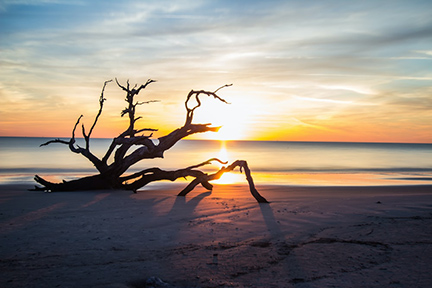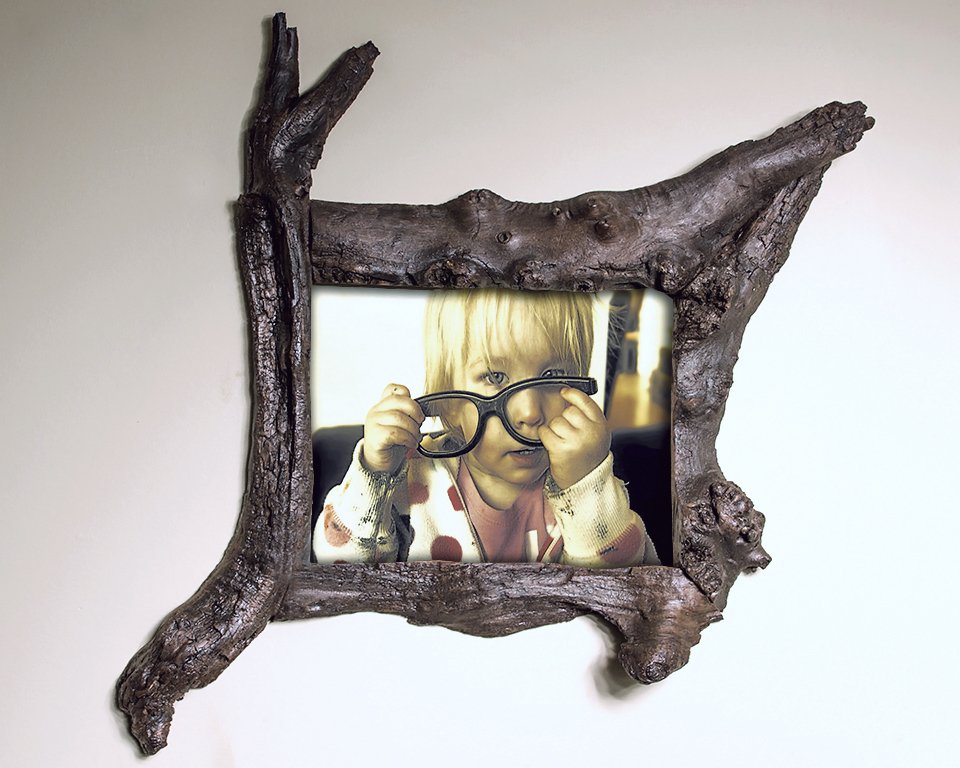How Does Driftwood Become Driftwood? | Driftwood Frames
What Is Driftwood and How Wood Becomes Driftwood
 Exactly What Is Driftwood?
Exactly What Is Driftwood?
What is driftwood? Driftwood is wood that has been washed out to sea, river, or other bodies of water, and then carried by the currents and tides until it washes up on a beach or shore. And I’m glad it does, because I need it to build driftwood frames!
Why Custom Wood Picture Frames Are So Popular as Gifts
The process of how wood becomes driftwood involves several steps.
- Tree falls or is uprooted: The first step in creating driftwood is a tree falling or being uprooted near a body of water such as a river or ocean. This can be due to a natural disaster such as a storm or flood, or simply because the tree’s roots have become weak or damaged.
- Transported by water: Once the tree is in the water, it is carried by the currents and tides. The water helps to smooth the rough edges of the wood and strip away any bark. This leaves the wood with a smooth, weathered appearance. But there are other factors that cause wood to become driftwood:
- Exposure to the elements: As the wood is carried by the water, it is exposed to the sun, wind, and salt water. This exposure causes the wood to dry out and become more resistant to decay.
- Settlement on a beach: Finally, the wood will wash up on a beach or shore. There it will continue to be exposed to the elements. Over time, the wood may be further weathered by wind, sand, and other natural forces. This creates the unique and often beautiful appearance of the wood, which has now become driftwood.

In summary, driftwood becomes driftwood when trees or branches fall or are uprooted near a body of water, and are then transported by the currents and tides until they wash up on a beach or shore. The exposure to the elements, including sun, wind, and salt water, causes the wood to become more weathered. It also becomes resistant to decay, creating the distinctive appearance of driftwood.
What Are Some Different Types of Driftwood?
Driftwood is a term used to describe any type of wood that has been washed up onto shore or deposited on the banks of a river, lake, or other body of water. The type of driftwood that you may find can vary greatly depending on the location and the species of trees in the surrounding area. Here are some different types of driftwood you may come across:
- Cedar driftwood: Cedar is a commonly found type of driftwood that is light in color and has a distinctive scent.
- Pine driftwood: Pine is another type of driftwood that is commonly found. It tends to be lighter in color than cedar and has a rougher texture.
- Oak driftwood: Oak is a hardwood that is less commonly found as driftwood but is highly sought after due to its durability and unique grain patterns.
- Redwood driftwood: Redwood is another type of driftwood that is highly prized for its beautiful reddish-brown color and distinctive grain patterns.
- Mangrove driftwood: Mangrove trees grow in coastal areas and their driftwood tends to be highly weathered and shaped by the ocean.
- Driftwood from tropical hardwoods: Some tropical hardwoods such as teak and mahogany can also be found as driftwood in coastal regions.
- Driftwood from exotic locations: Some driftwood can be found in areas where it is not native, such as driftwood from the Pacific Northwest found in Hawaii or Caribbean driftwood found in Florida.
The type of driftwood you may find will depend on the location and surrounding vegetation, and can range from light and airy to  dense and heavy.
dense and heavy.
Why Is Custom Framing So Expensive?
What Is the Difference Between Fresh Water and Salt Water Driftwood?
The main difference between fresh water and salt water driftwood is the type of wood and the environmental conditions that affect its appearance and composition.
Freshwater driftwood is usually derived from trees that grow near rivers, lakes, or other freshwater sources. The wood is exposed to the elements and can become waterlogged. This makes it heavy and saturated with water. Freshwater driftwood tends to have a smooth texture and a lighter color than saltwater driftwood. It may also have more visible knots, and other imperfections.
Why American Elm Wood Frames? | About American Elm Wood
Saltwater driftwood, on the other hand, comes from trees that grow near or in the ocean. The wood is exposed to salt water, wind, and other harsh conditions. This can erode the surface and create a weathered and rugged appearance. Saltwater driftwood may be darker in color, and have more irregular shapes and rough textures than freshwater driftwood.
What Is Driftwood Good For?
In addition to their physical characteristics, freshwater and saltwater driftwood can also have different ecological and cultural significance. For example, freshwater driftwood is an important habitat for many aquatic organisms, while saltwater driftwood may have cultural and historical significance for coastal communities.
Source for High Quality Frames Made from Driftwood

You guessed it! Craig’s Unique Frames’ driftwood frames are not like the usual driftwood frames you see on the internet. Driftwood is the most difficult wood to fashion into the style of frame that I craft. But if you are looking for a downright funky picture frame… well, have a look at the pictures below of a few of my driftwood frames, or visit the Etsy store.
What Exactly Is Driftwood Like to Work With?
Well, it can be challenging, for sure. It is often difficult or even impossible to simply cut 45 degree miters to fit the corners together like a regular (or even not-so-regular…) picture frame. There is usually some serious chiseling involved. As well, there is a ton of fitting, chiseling and measuring. Then more chiseling, measuring and re-fitting, measuring, chiseling, etc., etc.
The rabbet grooves in the back that hold the picture, glass and backing often have to be chiseled by hand. This is because parts of the wood sometimes extend past the edge that normally butts up against the fence of the table saw to cut said rabbet grooves.
I’m not whining, mind you. The frames made from driftwood tend be an enjoyable challenge. And that produces some wild and proud results. And finding the wood is a day at the beach. Literally!
You can see some more of my driftwood frames (as well as other types) here.

What Is the Purpose of a Picture Frame? DIY Driftwood Frames
Craigs Unique Frames Home Page

I love finding pieces of driftwood on the beach. My son is a carpenter and has used driftwood to incorporate into some furniture, like using it as a table leg or part of a bookshelf. But seeing you using driftwood for picture frames, is very unique and beautiful. I can imagine that it is difficult to make, but certainly makes for a very unique product.
Seeing that there is actually a difference between freshwater driftwood and saltwater driftwood, is very interesting. I would be curious to know how long the wood is in the water before it actually deteriorates and becomes driftwood.
Awesome to learn that driftwood is actually more resistant to decay because of the weathering. I will be sharing this post with my son.
I really like your picture frame. I could imagine the amount of time that goes into them as you are working with a really difficult material , I take it drift wood would behave a lot different to normal wood and be a lot harder. the make a unique product I like it.
Thanks a lot, Jason.
Some of the driftwood is really hard and some not so much.
The more difficult to work with stuff is the very curvey pieces.
but they make for some pretty wildly unusual frames, for those who are into that–like me!
Driftwood- this article enlightened me to what driftwood is. This was my learning of the day!
You mentioned that the 2 types of driftwood – Fresh Water type and Salt Water type would be different in composition and weathering. Which one would be more durable?
Can driftwood be used for furniture as well or due to asymmetric sizes, limited to frames only?
Great informative article here. Thanks for sharing.
Regards,
Rohit
Hey, Rohit. I think the durability depends on the type of wood, rather than whether or not it is fresh or salt water.
I have seen lots of amazing furniture made from driftwood.
Here is a link for you: https://www.pinterest.ca/pin/5…